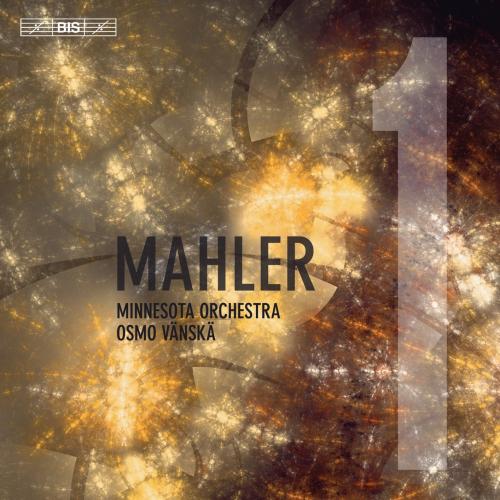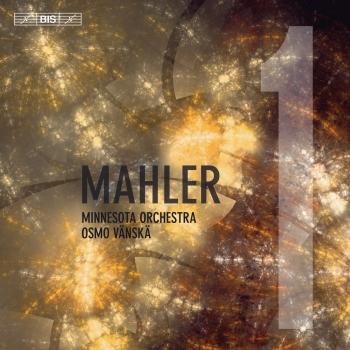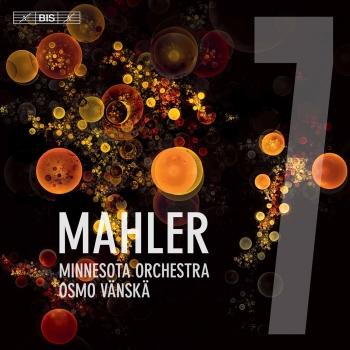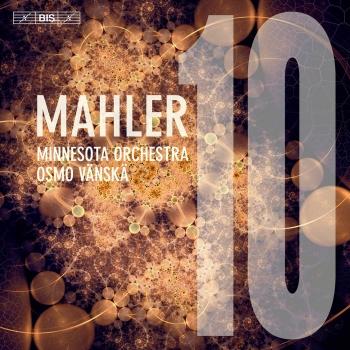
Mahler: Symphony No. 1 in D Major "Titan" Minnesota Orchestra & Osmo Vänskä
Album info
Album-Release:
2019
HRA-Release:
02.08.2019
Label: BIS
Genre: Classical
Subgenre: Orchestral
Artist: Minnesota Orchestra & Osmo Vänskä
Composer: Gustav Mahler (1860-1911)
Album including Album cover Booklet (PDF)
- Gustav Mahler (1860 - 1911): Symphony No. 1 in D Major "Titan":
- 1 Symphony No. 1 in D Major "Titan": I. Langsam, schleppend. Immer sehr gemächlich 16:06
- 2 Symphony No. 1 in D Major "Titan": II. Kräftig bewegt, doch nicht zu schnell 07:25
- 3 Symphony No. 1 in D Major "Titan": III. Feierlich und gemessen, ohne zu schleppen 11:23
- 4 Symphony No. 1 in D Major "Titan": IV. Stürmisch bewegt - Energisch 20:57
Info for Mahler: Symphony No. 1 in D Major "Titan"
The shimmering string harmonics at the opening of Gustav Mahler’s First Symphony bring to mind the suspended breath of spring, and will have signalled even to the very first audiences that a new symphonic era was being ushered in. Soon enough the composer introduces some of the elements that would become key components of his musical language: sounds of nature (here cuckoo calls) are combined with quasi-militaristic fanfares and ‘high-art’ chromatic wanderings in cellos, as if to illustrate Mahler’s view of the symphony as an all-embracing art form. The symphony, which the composer originally gave the subtitle ‘Titan’, borrows extensively from the song cycle Lieder eines fahrenden Gesellen. But Mahler also incorporates elements of Moravian popular music (in the second movement) and – in the slow third movement – famously quotes a minor-mode version of the children’s rhyme Bruder Martin (also known as Frere Jacques). The finale transports the listener to a world of Gothic theatricality reminiscent of Grand Opera, before arriving – after a number of false starts – at the symphony’s heroic chorale-like ending. This symphonic ‘world-in-microcosm’ is here brought to life by the Minnesota Orchestra and Osmo Vanska on the fourth installment in a series which has earned the team the description ‘among the finest exponents of Mahler’s music’ on the website allmusic.com.
Minnesota Orchestra
Osmo Vänskä, conductor
Osmo Vänskä
the Minnesota Orchestra’s tenth music director, is renowned internationally for his compelling interpretations of the standard, contemporary and Nordic repertoires. He has led the Orchestra on four major European tours—drawing rave reviews for performances at European music festivals including the BBC Proms and Edinburgh Festival, and for appearances at London’s Barbican Hall, the Royal Concertgebouw in Amsterdam, the Vienna Musikverein and the Berlin Philharmonie. He has also led regular tours to communities across Minnesota, including a September 2014 performance in Bemidji, as part of the Orchestra’s Common Chords initiative. Vänskä served as music director from 2003 to 2013, resigned during the organization’s labor dispute, and accepted reappointment to the position in May 2014.
Vänskä’s recording projects with the Minnesota Orchestra have met with great success. Most recently he recorded an album of Beethoven and Mozart piano concertos with soloist Yevgeny Sudbin and two albums of Sibelius symphonies, all for BIS; both Sibelius discs were nominated for a Grammy Award, and the album featuring the First and Fourth Symphonies won the 2014 Grammy Award for Best Orchestral Performance. Previous releases include Beethoven’s final two piano concertos with Yevgeny Sudbin; a BIS album of Bruckner’s Fourth (Romantic) Symphony; a two-CD set from Hyperion featuring pianist Stephen Hough in live, in-concert recordings of Tchaikovsky’s piano concertos and Concert Fantasia; and a cycle of the complete Beethoven symphonies for BIS, with each album drawing superlative praise worldwide, and two—one of the Ninth Symphony and one of the Second and Seventh—receiving Grammy and Classic FM Gramophone award nominations, respectively.
As a guest conductor, he has led all the major American and European orchestras. He has appeared with the symphony orchestras of Boston, Chicago, Cleveland, Los Angeles, New York, Philadelphia, San Francisco and Washington, D.C., in this country. Abroad he has led the Berlin Philharmonic, London’s BBC Symphony, London Philharmonic, Royal Concertgebouw Orchestra, Vienna Symphony, Leipzig Gewandhaus Orchestra, Czech Philharmonic, Helsinki Philharmonic, Hong Kong Philharmonic, Yomiuri Nippon Symphony Orchestra and other major ensembles. His schedule in 2014-15 includes engagements with the London Philharmonic, Vienna Symphony, Berlin Konzerthausorchester, Shanghai Symphony, Guangzhou Symphony and additional major symphony orchestras in Australia, Brazil, Finland, South Africa and Spain.
Vänskä has been appointed principal guest conductor of the Iceland Symphony Orchestra in Reykjavík, beginning in fall 2014. He is also conductor laureate of the Lahti Symphony, which he served as music director from 1988 to 2008, transforming it into one of Finland’s flagship orchestras during his tenure. Under his leadership, the Lahti Symphony received international attention for performances in London, Birmingham and New York, and for its award-winning Sibelius recordings on the BIS label.
Vänskä has recorded extensively on the BIS and Hyperion labels. His Sibelius albums with the Lahti Symphony Orchestra for BIS have amassed numerous awards, including a 1996 Gramophone Award and Cannes Classical Award for the original version of the Fifth Symphony. His first-ever complete recording of The Tempest won the 1993 Prix Académie Charles Cros, and his disc of the original version of the Sibelius Violin Concerto with Leonidas Kavakos won 1991 Gramophone Awards for Record of the Year and Best Concerto Recording.
Vänskä, who began his music career as a clarinetist, held the co-principal chair of the Helsinki Philharmonic (1977-82) and the principal chair of the Turku Philharmonic (1971-76). Following conducting studies under Jorma Panula at Finland’s Sibelius Academy, he was awarded first prize in the 1982 Besançon International Young Conductor’s Competition. Three years later he began his tenure with the Lahti Symphony as principal guest conductor, while also serving as music director of the Iceland Symphony Orchestra and the Tapiola Sinfonietta. In addition, Vänskä served as chief conductor of the BBC Scottish Symphony Orchestra of Glasgow (1997-2002).
Since returning to the clarinet at the Minnesota Orchestra’s 2005 Sommerfest, Vänskä has performed in chamber ensembles at Orchestra Hall, other Twin Cities venues, Napa Valley’s Music in the Vineyards, the Grand Teton Music Festival and the Mostly Mozart Festival in New York.
During his time in Minnesota, Vänskä has explored an interest in composition. The Orchestra performed his first orchestral work, Here!...Beyond? in 2006, and his second work, The Bridge—a response to Minnesota’s I-35W bridge collapse—was heard at a concert in 2008.
Honors and distinctions awarded to Vänskä include an honorary doctorate from the University of Glasgow, given in recognition of his tenure as chief conductor of the BBC Scottish Symphony. In May 2002 he was honored with a Royal Philharmonic Society Award for his outstanding contribution to classical music during 2001. Musical America named Vänskä 2005 Conductor of the Year, and in 2008 he received an honorary doctorate from the University of Minnesota as well as a Champion of New Music Award from the American Composers Forum. In 2010 he received the Ditson Award from Columbia University, honoring him in particular for his support of American music, and was named by the Minneapolis Star Tribune as its 2010 Artist of the Year.
Booklet for Mahler: Symphony No. 1 in D Major "Titan"
















